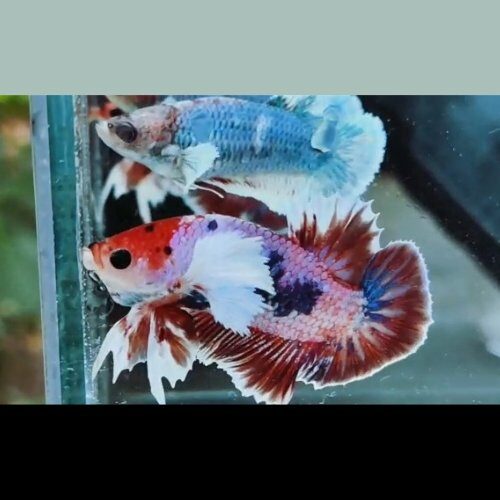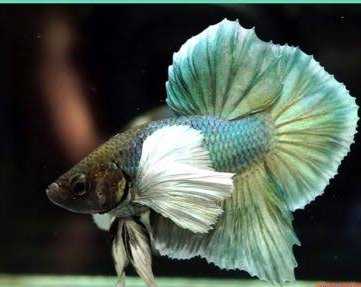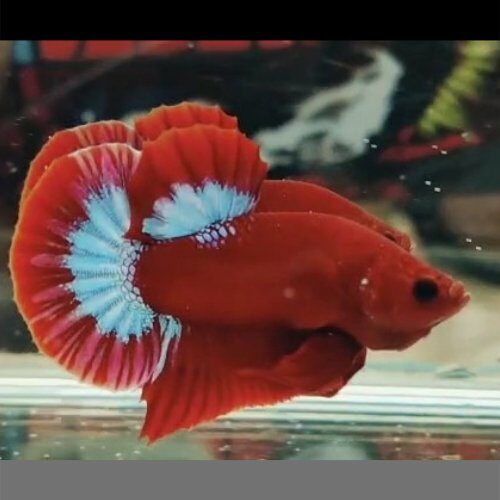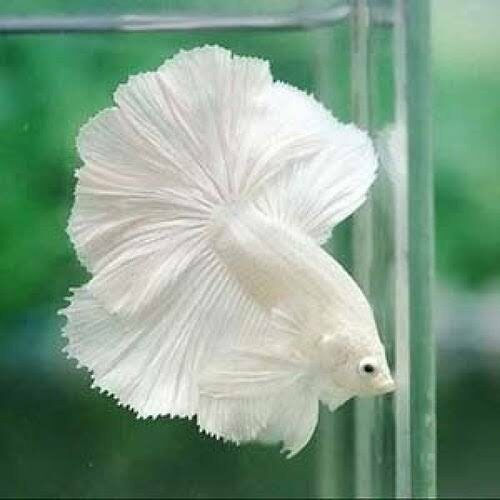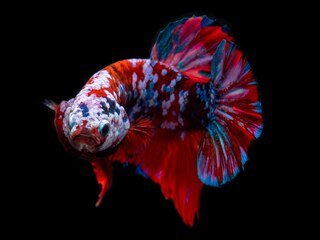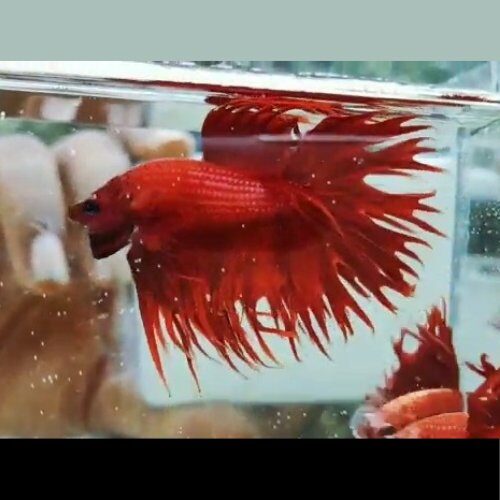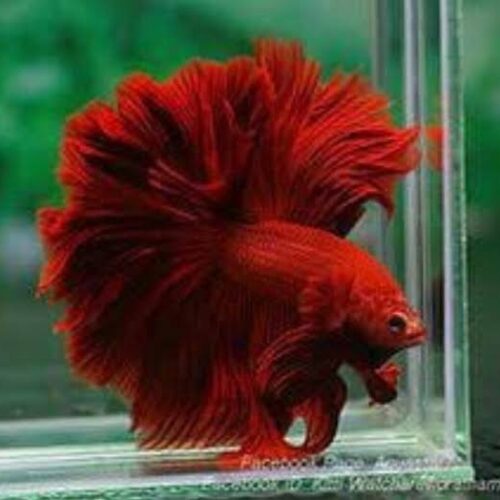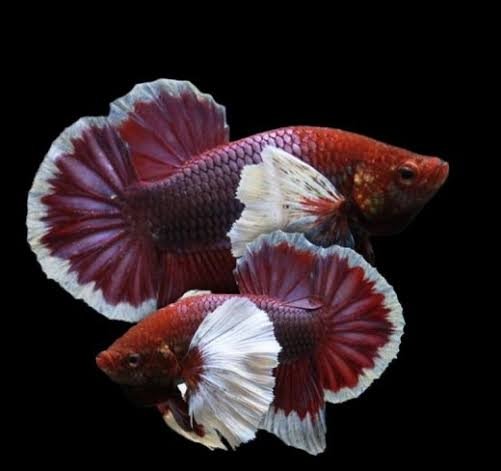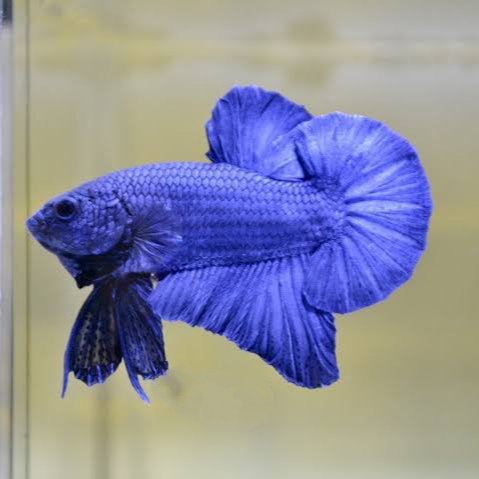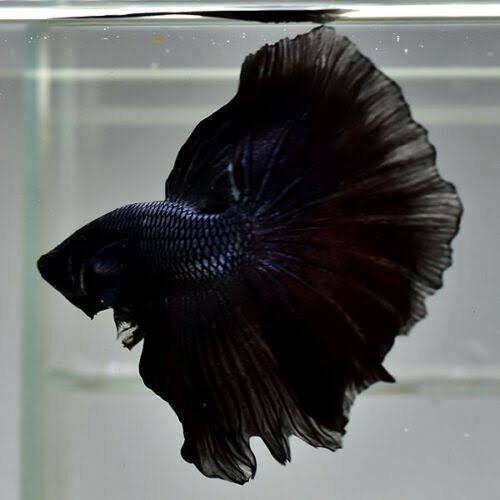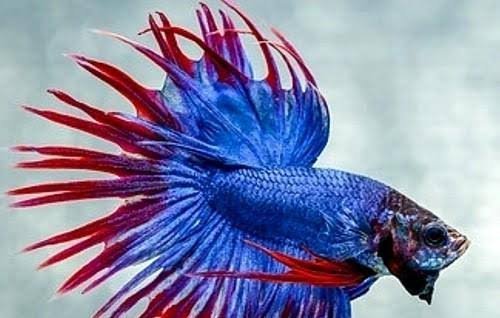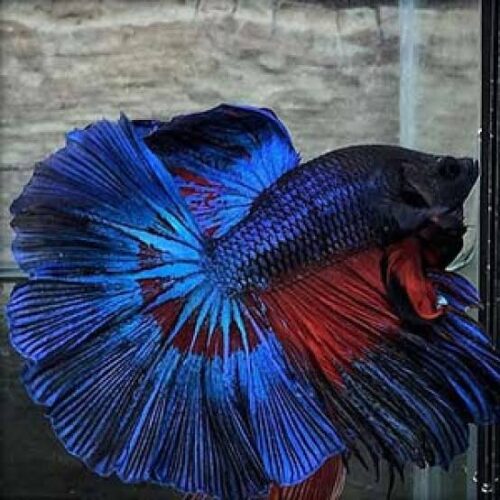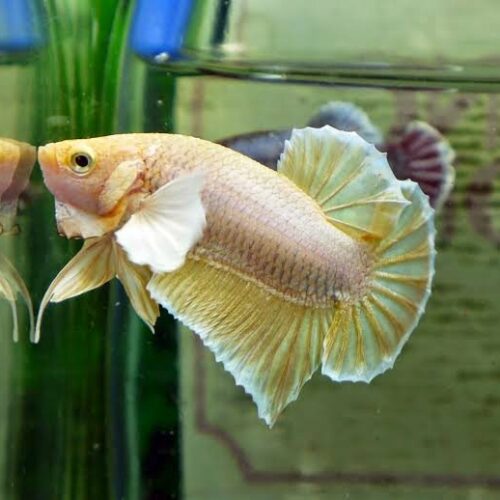Betta Fishes
Betta fishes, or Siamese fighting fish, are popular aquarium fish. They are often called ‘bettas’ and are part of the gourami family. They are well known for being territorial fish and ‘fighting’ if two are placed together or they see their reflections. Betta fish originiate from Cambodia, Vietnam, and Thailand natively. Despite popular belief, they are not found in puddles. In the wild, they live in standing waters, often in rice paddies, floodplains, or canals. In the wild, they are less territorial due to the large space they live in – they will only spar, not fight to the death.
Origin and Distribution
Bettas originate in the shallow waters of Thailand (formerly called Siam, hence their name), Indonesia, Malaysia, Vietnam, and parts of China. These areas are home to rice paddies, ponds, slow-moving streams, and swamps, all of which are home to bettas. Today bettas have been introduced into many locations, giving rise to non-native populations in a number of countries.
Colors and Markings
The brilliant coloration and long flowing fins of the male betta make it one of the most well known of aquarium fish. Females are usually not as highly colored and have much shorter fins. In nature, this species is not usually brightly colored.
However, captive breeding programs have resulted in a wide variety of colors, including white, yellow, orange, red, pink, blue, green, turquoise, brown, and black. A myriad of combinations can be seen, from solid colors to those with different fin and body colors, to patterned colors. Fin types have also changed due to selective breeding. Veil tails have been joined by crown tails, deltas, fans, half moons, lyre, and split tails, to name a few.
Both sexes have a torpedo-shaped body and an upturned mouth geared for eating at the surface. Mature adults reach a size of two to three inches, with females being slightly smaller than the males. A unique feature of this species is the presence of a labyrinth organ that allows them to take oxygen from the atmosphere instead of from water, thus allowing them to survive in low-oxygen pools.
Tankmates
Males cannot be kept together unless there are separators in the tank. Multiple females can generally be kept together without problems, and a single male can also be added to the mix. They can be kept with other peaceful species of fish, as long as they are small and are not fin-nipping types, such as tiger barbs.
Betta Habitat and Care
Bettas are one of the most recognized, most colorful, and often most controversial fish in the freshwater aquarium hobby. Debates rage about the appropriateness of keeping them in small bowls. To fully understand their needs it is important to become familiar with their native habitat, where they live in large rice paddies, shallow ponds, and even in very slow-moving streams. Although many fish keepers are aware that bettas come from shallow waters, the water temperature is often overlooked.
The home countries of the betta are tropical, which means the water temperature is quite warm, often into the 80s. Bettas thrive on heat and will become increasingly listless when the water temperature falls below 75 F. Water temperature is perhaps the biggest argument against keeping a betta in a tiny bowl, which cannot readily be heat controlled.
Even though bettas do well in waters low in dissolved oxygen, that does not mean they require less oxygen than other fish. Bettas have a special respiratory organ that allows them to breathe air directly from the surface. In fact, they inherently must do so. In experiments where the labyrinth organ was removed, the fish died from suffocation even though the water was saturated with oxygen. For this reason, bettas must have access to the water surface to breathe air directly from the atmosphere.
Optimally, the water for keeping bettas healthy should be soft, warm, with a neutral to slightly acidic pH. Water movement should be kept to a minimum, which means that power filters and powerheads are not suitable. Bettas may be kept in a community tank as long as the water conditions are met, and if no aggressive or fin-nipping fish are present. However, only one male may be kept in each aquarium, unless they are separated by a barrier.
The use of plastic boxes that hang inside the aquarium is a suitable option for keeping more than one betta in a tank, or for keeping them in a tank with fish that might nip their fins. Females will generally not fight with each other and may be kept together in the same open space.
Diet and Feeding
In nature, bettas subsist almost exclusively on insects and insect larvae. They are built with an upturned mouth that is well suited to snatching any hapless insect that might fall into the water. Internally their digestive system is geared for meat, having a much shorter alimentary track than vegetarian fish. For this reason, live foods are the ideal diet for the betta, however, they will adapt to eating flake foods and frozen or freeze-dried foods.
Brine shrimp, Daphnia, plankton, tubifex, glassworms, and beef heart, are all excellent options that may be found frozen or freeze-dried. If flake food is fed, it should be supplemented with frozen and freeze-dried foods, and if possible, live foods.
Gender Differences
Males typically are more brilliantly colored and have longer and flowing fins. They also have a more distinct “beard” (under the gill coverings) and are larger overall than the females. Females have short fins and will display vertical stripes and an egg spot when ready to mate.
Breeding the Betta
Bettas have a fairly short lifespan and are most successful as breeders when they are under a year old; bettas in pet shops are usually at least six months old. They breed in bubble nests and do not require a large tank or special equipment.
Most breeders find that a bare-bottomed tank of roughly ten gallons works well, although smaller tanks are also suitable. Ideally, the fish should be conditioned prior to breeding, by feeding them a diet of live foods. Breeder tank water should be at a pH of about 7.0, and temperature around 80 or slightly above.
The male will blow an elaborate bubble nest when he is ready to spawn. The female should be provided with a hiding place, as males may become aggressive during courtship. Even with a hiding place, it is common for the female to lose a few scales or have their fins frayed during spawning.
When they are ready to spawn, the pair will display intense coloration and begin circling each other under the bubble nest. The male will wrap himself around the female who has turned on her back. As she expels the eggs, they are fertilized and begin to sink. The male will scoop up the eggs and spit them into the nest. From this point on, the male will tend the brood. It is advisable to remove the female, as the male may become aggressive towards her as he tends his young.
The male will continue to tend the bubble nest, spitting eggs that fall out back into the nest. In one to two days the eggs will hatch, and the fry will be visible hanging in the bubble nest with their tails pointing downward. They will feed off their yolk sack for another 36 hours, during which time the male will continue to pick up any fry that falls out of the nest. The male should be removed within two days after the fry hatch, as they may eat the young once they are free-swimming.
The fry should be fed a few feedings daily of baby brine shrimp or very fine baby food. Tetra makes a dry mixture specifically for egglaying fish, and many pet shops carry frozen baby brine shrimp. Take care not to overfeed, as the uneaten food will foul the water and can quickly prove lethal to the fry.
-
Betta Fishes
Avathar Plakad Betta(1 pair)
Original price was: ₹1,499.00.₹899.00Current price is: ₹899.00. Add to cartProgressive marble gene so his/her colors will get more intensified overtime
-
Betta Fishes
Blue Crowntail Betta(1pair)
Original price was: ₹599.00.₹349.00Current price is: ₹349.00. Add to cartjewel-bright colors and spectacular fins and come in a wide variety of morphs.
-
Betta Fishes
Candy Dumpo hmpk Betta(1 pair)
Original price was: ₹1,500.00.₹999.00Current price is: ₹999.00. Add to cartCandy Multi Colour pattern Dumpo Ear hmpk betta
-
Betta Fishes
Full Red OHM Betta(1 pair)
Original price was: ₹499.00.₹299.00Current price is: ₹299.00. Add to cart1 pair(1 male 1 female)
All India Courier possible
-
Betta Fishes
Green Dumpo hmpk Betta(1 pair)
Original price was: ₹600.00.₹399.00Current price is: ₹399.00. Add to cartGreen Coloured Body with White Dumpo ear hmpk Betta
-
Betta Fishes
Hellboy Plakad Betta(1 pair)
Original price was: ₹1,499.00.₹799.00Current price is: ₹799.00. Add to cartHellboy Plakat Betta boasts lots of red coloration, just like its comic book and movie character namesake!
-
Betta Fishes
Milky White Ohm Betta(1 pair)
Original price was: ₹500.00.₹299.00Current price is: ₹299.00. Add to cart1 pair(1 male 1 female)
Milky Solid White Coloured ohm betta
-
Betta Fishes
Multi Galaxy hmpk Betta(1 pair…
Original price was: ₹1,500.00.₹999.00Current price is: ₹999.00. Add to cartMulti Colour Galaxy on Body of hmpk betta
-
Betta Fishes
Red Crowntail Betta(1 pair)
Original price was: ₹599.00.₹349.00Current price is: ₹349.00. Add to cartTail is like a beautiful creeped red Thread
-
Betta Fishes
Red Galaxy hmpk Betta(1 pair)
Original price was: ₹1,299.00.₹799.00Current price is: ₹799.00. Add to carthigh-grade coloration fish of the ever-popular plakat body and fin variety
-
Betta Fishes
Red Rosetail Betta(1 pair)
Original price was: ₹1,000.00.₹799.00Current price is: ₹799.00. Add to cartRed Solid Colour Rosetail betta
-
Betta Fishes
Salamander Dumpo Ear hmpk Bett…
Original price was: ₹900.00.₹499.00Current price is: ₹499.00. Add to cartSalamander betta with White Dumpo Ear
-
Betta Fishes
Yellow FCCP Plakad Betta (1 pa…
Original price was: ₹2,000.00.₹1,299.00Current price is: ₹1,299.00. Add to cartYellow Body with FCCP Premium Body
-
Betta Fishes
Yellow Galaxy hmpk Betta(1 pai…
Original price was: ₹1,499.00.₹899.00Current price is: ₹899.00. Add to cartYellow Galaxy patterned hmpk betta
-
Aquarium Fishes (Ornamental Fishes)
Koi Galaxy Betta
Original price was: ₹2,000.00.₹1,600.00Current price is: ₹1,600.00. Add to cartSingle Piece
-
Aquarium Fishes (Ornamental Fishes)
Blue Hmpk Betta
Original price was: ₹900.00.₹599.00Current price is: ₹599.00. Add to cartSingle Piece
-
Aquarium Fishes (Ornamental Fishes)
Black Ohm Betta Pair
Original price was: ₹500.00.₹399.00Current price is: ₹399.00. Add to cartSingle Pair
-
Betta Fishes
Blue Body Redtail Betta(1 pair…
Original price was: ₹700.00.₹399.00Current price is: ₹399.00. Add to cartMale bettas don’t like hanging around other bettas and will fluff up their long, flowy fins and fight
-
Betta Fishes
Mustard Gas Betta(1pair)
Original price was: ₹800.00.₹349.00Current price is: ₹349.00. Add to cartBlack Mustard Gas Halfmoon Betta (Betta splendens) is a very high-grade coloration fish of the classic longfin variety
-
Betta Fishes
Crowntail Males(2 pcs)
Original price was: ₹800.00.₹349.00Current price is: ₹349.00. Add to cartCrown Tail Betta is an active freshwater species; also, they are notoriously good jumpers
-
Betta Fishes
Black Orchid plakad Betta(1pai…
Original price was: ₹700.00.₹449.00Current price is: ₹449.00. Add to cartThey are native to Thailand’s Mekong and Phraya rivers, where they can be found living in ponds, marshes, and flood plains.
-
Betta Fishes
Red Plakad Betta(1pair)
Original price was: ₹700.00.₹449.00Current price is: ₹449.00. Add to cartTheir tails and fins remain brightly colored as they are not scaled
-
Betta Fishes
Peacock Blue Betta(1pair)
Original price was: ₹700.00.₹349.00Current price is: ₹349.00. Add to cartfused at a small point at the top, making it look similar to a fantail goldfish.
-
Betta Fishes
Golden Dumpo Ear Betta(1pair)
Original price was: ₹700.00.₹499.00Current price is: ₹499.00. Add to cartelephant ear bettas due to their large head growths,
Betta fish, or Siamese fighting fish, are popular aquarium fish. They are often called ‘bettas’ and are part of the gourami family. They are well known for being territorial fish and ‘fighting’ if two are placed together or they see their reflections. Betta fish originiate from Cambodia, Vietnam, and Thailand natively. Despite popular belief, they are not found in puddles. In the wild, they live in standing waters, often in rice paddies, floodplains, or canals. In the wild, they are less territorial due to the large space they live in – they will only spar, not fight to the death.
Origin and Distribution
Bettas originate in the shallow waters of Thailand (formerly called Siam, hence their name), Indonesia, Malaysia, Vietnam, and parts of China. These areas are home to rice paddies, ponds, slow-moving streams, and swamps, all of which are home to bettas. Today bettas have been introduced into many locations, giving rise to non-native populations in a number of countries.
Colors and Markings
The brilliant coloration and long flowing fins of the male betta make it one of the most well known of aquarium fish. Females are usually not as highly colored and have much shorter fins. In nature, this species is not usually brightly colored.
However, captive breeding programs have resulted in a wide variety of colors, including white, yellow, orange, red, pink, blue, green, turquoise, brown, and black. A myriad of combinations can be seen, from solid colors to those with different fin and body colors, to patterned colors. Fin types have also changed due to selective breeding. Veil tails have been joined by crown tails, deltas, fans, half moons, lyre, and split tails, to name a few.
Both sexes have a torpedo-shaped body and an upturned mouth geared for eating at the surface. Mature adults reach a size of two to three inches, with females being slightly smaller than the males. A unique feature of this species is the presence of a labyrinth organ that allows them to take oxygen from the atmosphere instead of from water, thus allowing them to survive in low-oxygen pools.
Tankmates
Males cannot be kept together unless there are separators in the tank. Multiple females can generally be kept together without problems, and a single male can also be added to the mix. They can be kept with other peaceful species of fish, as long as they are small and are not fin-nipping types, such as tiger barbs.
Betta Habitat and Care
Bettas are one of the most recognized, most colorful, and often most controversial fish in the freshwater aquarium hobby. Debates rage about the appropriateness of keeping them in small bowls. To fully understand their needs it is important to become familiar with their native habitat, where they live in large rice paddies, shallow ponds, and even in very slow-moving streams. Although many fish keepers are aware that bettas come from shallow waters, the water temperature is often overlooked.
The home countries of the betta are tropical, which means the water temperature is quite warm, often into the 80s. Bettas thrive on heat and will become increasingly listless when the water temperature falls below 75 F. Water temperature is perhaps the biggest argument against keeping a betta in a tiny bowl, which cannot readily be heat controlled.
Even though bettas do well in waters low in dissolved oxygen, that does not mean they require less oxygen than other fish. Bettas have a special respiratory organ that allows them to breathe air directly from the surface. In fact, they inherently must do so. In experiments where the labyrinth organ was removed, the fish died from suffocation even though the water was saturated with oxygen. For this reason, bettas must have access to the water surface to breathe air directly from the atmosphere.
Optimally, the water for keeping bettas healthy should be soft, warm, with a neutral to slightly acidic pH. Water movement should be kept to a minimum, which means that power filters and powerheads are not suitable. Bettas may be kept in a community tank as long as the water conditions are met, and if no aggressive or fin-nipping fish are present. However, only one male may be kept in each aquarium, unless they are separated by a barrier.
The use of plastic boxes that hang inside the aquarium is a suitable option for keeping more than one betta in a tank, or for keeping them in a tank with fish that might nip their fins. Females will generally not fight with each other and may be kept together in the same open space.
Diet and Feeding
In nature, bettas subsist almost exclusively on insects and insect larvae. They are built with an upturned mouth that is well suited to snatching any hapless insect that might fall into the water. Internally their digestive system is geared for meat, having a much shorter alimentary track than vegetarian fish. For this reason, live foods are the ideal diet for the betta, however, they will adapt to eating flake foods and frozen or freeze-dried foods.
Brine shrimp, Daphnia, plankton, tubifex, glassworms, and beef heart, are all excellent options that may be found frozen or freeze-dried. If flake food is fed, it should be supplemented with frozen and freeze-dried foods, and if possible, live foods.
Gender Differences
Males typically are more brilliantly colored and have longer and flowing fins. They also have a more distinct “beard” (under the gill coverings) and are larger overall than the females. Females have short fins and will display vertical stripes and an egg spot when ready to mate.
Breeding the Betta
Bettas have a fairly short lifespan and are most successful as breeders when they are under a year old; bettas in pet shops are usually at least six months old. They breed in bubble nests and do not require a large tank or special equipment.
Most breeders find that a bare-bottomed tank of roughly ten gallons works well, although smaller tanks are also suitable. Ideally, the fish should be conditioned prior to breeding, by feeding them a diet of live foods. Breeder tank water should be at a pH of about 7.0, and temperature around 80 or slightly above.
The male will blow an elaborate bubble nest when he is ready to spawn. The female should be provided with a hiding place, as males may become aggressive during courtship. Even with a hiding place, it is common for the female to lose a few scales or have their fins frayed during spawning.
When they are ready to spawn, the pair will display intense coloration and begin circling each other under the bubble nest. The male will wrap himself around the female who has turned on her back. As she expels the eggs, they are fertilized and begin to sink. The male will scoop up the eggs and spit them into the nest. From this point on, the male will tend the brood. It is advisable to remove the female, as the male may become aggressive towards her as he tends his young.
The male will continue to tend the bubble nest, spitting eggs that fall out back into the nest. In one to two days the eggs will hatch, and the fry will be visible hanging in the bubble nest with their tails pointing downward. They will feed off their yolk sack for another 36 hours, during which time the male will continue to pick up any fry that falls out of the nest. The male should be removed within two days after the fry hatch, as they may eat the young once they are free-swimming.
The fry should be fed a few feedings daily of baby brine shrimp or very fine baby food. Tetra makes a dry mixture specifically for egglaying fish, and many pet shops carry frozen baby brine shrimp. Take care not to overfeed, as the uneaten food will foul the water and can quickly prove lethal to the fry.




